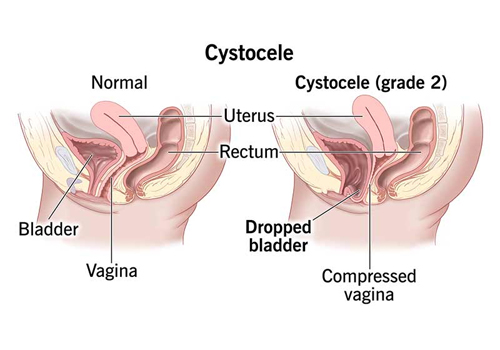
Cystocoele repair
Cystocele Repair (Anterior Vaginal Wall Repair)
Cystocele repair is a surgical procedure to correct a condition where the bladder bulges into the vaginal wall. This condition, also known as a prolapsed bladder, occurs due to weakened or stretched pelvic floor muscles and tissues. It is most commonly caused by childbirth, aging, or strain on the pelvic floor.
Types of Cystocele
- Mild (Grade 1): The bladder droops slightly into the vagina.
- Moderate (Grade 2): The bladder prolapses to the opening of the vagina.
- Severe (Grade 3): The bladder bulges out through the vaginal opening.
Indications for Cystocele Repair
Surgical repair is recommended if:
- Symptoms are severe and affect quality of life.
- Non-surgical treatments (e.g., pelvic floor exercises, pessary use) fail.
- Symptoms include:
- Urinary incontinence or difficulty urinating.
- Frequent urinary tract infections.
- Pressure, discomfort, or a bulging sensation in the pelvic area.
Procedure
-
Pre-Surgery Preparation:
- Comprehensive medical evaluation.
- Stopping certain medications (e.g., blood thinners).
- Fasting as directed by the surgeon.
-
During the Surgery:
- Anesthesia: General or regional anesthesia is administered.
- Incision: A small incision is made in the vaginal wall.
- Bladder Support: Excess or weakened tissue is removed, and the remaining tissue is tightened. In some cases, a synthetic mesh may be used to reinforce the repair.
- Closure: The incision is closed with dissolvable sutures.
-
Duration: The surgery typically takes 1-2 hours.
Post-Surgery Recovery
-
Hospital Stay:
- May last 1-2 days, depending on recovery and any complications.
-
Activity Restrictions:
- Avoid heavy lifting, strenuous activities, and sexual intercourse for 6-8 weeks.
- Gradually increase physical activity as advised by the surgeon.
-
Pain and Swelling:
- Mild discomfort and swelling are normal; manage with prescribed pain medications.
-
Bladder Care:
- A catheter may be placed temporarily to help with urination.
- Follow-up appointments are necessary to monitor healing.
Risks and Complications
-
Short-Term Risks:
- Bleeding, infection, or pain at the surgical site.
- Difficulty urinating.
-
Long-Term Risks:
- Recurrence of the prolapse.
- Urinary incontinence or overactive bladder symptoms.
- Vaginal scarring or discomfort during intercourse.
Alternatives to Surgery
-
Pelvic Floor Exercises (Kegels):
- Strengthen pelvic floor muscles and support the bladder.
-
Pessary Use:
- A removable device inserted into the vagina to support the bladder.
-
Lifestyle Changes:
- Weight loss, avoiding heavy lifting, and managing chronic coughing or constipation.
Outlook
Most women experience significant symptom relief and improved quality of life after cystocele repair. However, adherence to post-surgery care and lifestyle changes is crucial for long-term success.

